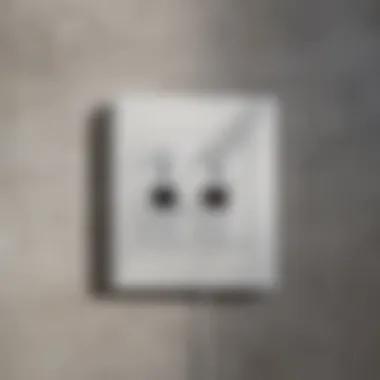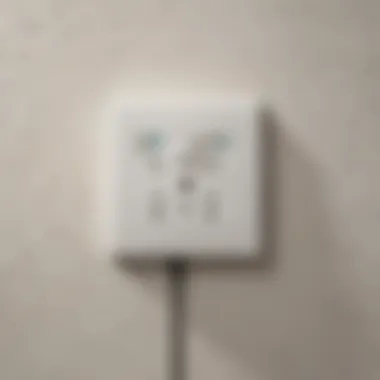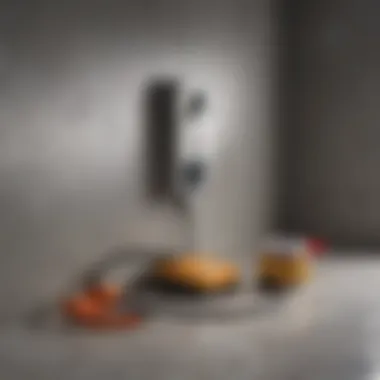Choosing the Best GFCI Outlet for Your Bathroom


Intro
When it comes to creating a bathroom that is both functional and stylish, selecting the right Ground Fault Circuit Interrupter (GFCI) outlet becomes essential. In a space where water and electricity coexist, safety standards dictate specific requirements for electrical installations. This article delves into the various aspects of choosing a GFCI outlet that aligns with not only safety protocols but also seamlessly blends into your bathroom design.
A GFCI outlet works by protecting against electrical shocks. This is critical in bathroom environments where the risk of electric shock significantly increases due to moisture. Understanding your options and ensuring compliance with the National Electrical Code (NEC) can safeguard your well-being while contributing to a well-designed bathroom.
Moreover, factors like design compatibility and trending styles play a role in how effectively a GFCI outlet can enhance your aesthetic choices. Amid selections of materials and color palettes, it is crucial to balance functionality with visual appeal.
This guide aims to cover:
- Safety features essential for GFCI outlets;
- Regulatory requirements related to bathroom installations;
- Product recommendations that fit various designs;
- Installation tips that ensure correctness and compliance.
With this comprehensive look at GFCI outlets for bathrooms, homeowners can make informed decisions that bolster safety while enhancing the overall design.
Understanding GFCI Outlets in Bathrooms
Bathroom safety is of paramount importance, especially considering the high interaction with water. Ground Fault Circuit Interrupter (GFCI) outlets play a critical role in this environment. They are designed to protect individuals from electrical shock and help minimize hazards that arise from water and electricity intersecting. By choosing the right GFCI outlet, homeowners ensure not only protection but also enhance the usability and aesthetic appeal of their bathrooms.
Definition and Purpose
A GFCI outlet is an electrical receptacle meant to shut off power when it detects an imbalance in electrical current. This imbalance can indicate that current is escaping to the ground, which can happen if someone comes into contact with a live part of the electrical system. The primary purpose of GFCI outlets is to prevent electrical shock, especially in wet locations such as bathrooms, kitchens, and outdoors where water can lead to dangerous situations.
These outlets differ from regular outlets in their ability to monitor electrical current. A GFCI outlet reacts in milliseconds, cutting off the electrical supply before a significant shock can occur. For instance, if a person accidentally drops a hairdryer into a sink, the GFCI outlet will quickly interrupt the circuit, potentially saving a life.
Importance of Ground Fault Protection
Ground fault protection is essential for maintaining safety standards in homes. In wet environments, the risk of electrical accidents increases significantly. GFCI outlets are designed to mitigate this risk by detecting ground faults and acting promptly.
"In areas where water and electricity coexist, GFCI outlets provide critical safety measures to prevent accidents."
The relevance of ground fault protection extends beyond mere compliance with electrical codes. Installing GFCI outlets in bathrooms helps protect children, elderly family members, or anyone who might be vulnerable to electrical accidents. They offer peace of mind knowing that the electrical system is equipped to handle potential hazards effectively. Furthermore, using GFCI outlets can lead to lower insurance costs due to the enhanced safety they provide.
Overall, understanding GFCI outlets and their importance forms the foundation for selecting the optimal models for bathroom use. This knowledge allows homeowners to make informed decisions about safety and functionality, ultimately improving the overall experience in their bathrooms.
Regulatory Standards for GFCI Outlets
Understanding the regulatory standards governing GFCI outlets is crucial for homeowners looking to enhance safety in their bathrooms. These standards dictate how GFCI outlets should be installed and maintained to protect users from electrical shock hazards, especially in areas with high moisture such as bathrooms.
Adhering to these regulations not only ensures personal safety but also aligns with legal requirements that may affect insurance claims and property values. Homeowners must be aware of national codes, as well as local variations, which play a significant role in determining the specific requirements for GFCI outlets.


National Electric Code Requirements
The National Electric Code (NEC) establishes minimum safety requirements for electrical installations in the United States. Section 210.8 of the NEC specifically addresses ground-fault protection. According to these regulations, GFCI outlets must be installed in bathrooms to prevent electrical accidents. This requirement applies to all 125-volt, single-phase receptacles that are located within six feet of a sink.
Having a GFCI outlet means that any ground fault detected will result in a quick disconnection of the power supply, thereby greatly reducing the risk of electrical shock. The NEC emphasizes the need for GFCI protection not only in bathrooms but also in kitchens, garages, and outdoor areas. Compliance with NEC standards is critical for maintaining a safe living environment.
State and Local Code Variations
While the National Electric Code provides a foundational framework, state and local building codes can have variations that affect the installation and use of GFCI outlets in bathrooms. Homeowners should consult their local building authority to understand specific local amendments that may impose stricter regulations or additional requirements.
Local codes may specify the type of GFCI outlets allowed, their placement, and whether additional safety features are needed. This can include the installation of tamper-resistant GFCI outlets in homes with young children. Failure to comply with these local standards can lead to fines or complications during property inspections or sales, underscoring the importance of awareness in meeting all applicable building codes.
Factors to Consider for Bathroom GFCI Outlets
When selecting a GFCI outlet for your bathroom, several crucial factors come into play. The right outlet not only provides safety but also contributes to the overall functionality and aesthetics of the space. Understanding these elements is essential for making an informed decision.
Amperage Rating
Amperage rating is a significant factor that determines how much electrical current an outlet can handle safely. In most residential bathrooms, a standard 15-amp GFCI outlet is adequate. However, in instances where multiple devices may be used simultaneously, a 20-amp outlet could be necessary. Choosing an outlet with the correct amperage ensures it can effectively handle the load without tripping or causing hazards. Always consider the combined amperage of the devices used in the bathroom, such as hairdryers, shavers, and other electronics. It is advisable to consult with an electrician to assess your specific needs and ensure compliance with local codes.
Weatherproof and Moisture Resistance
Bathrooms are inherently moist places, making weatherproofing and moisture resistance vital characteristics of a GFCI outlet. Outlets designed for wet environments need to be rated appropriately to prevent malfunction. Look for products that are listed as "weather-resistant" or have an "in-use" cover to protect against moisture. This ensures longevity and reliable performance, especially in conditions that are damp or humid. Regular inspections for signs of wear or damage can also prolong the outlet’s lifespan and maintain safety standards.
Always prioritize GFCI outlets with moisture resistance in bathrooms to prevent electrical hazards.
Aesthetic Compatibility with Bathroom Design
Aesthetics often play a key role in home improvement choices. Selecting a GFCI outlet that complements your bathroom’s design can help maintain a cohesive style. Outlets come in various colors and finishes, including white, cream, and bronze. Additionally, some models have sleek designs that fit modern interiors. Take time to consider how the outlet will integrate into the overall décor. This ensures that functionality does not come at the expense of visual appeal, creating an environment that is both practical and pleasing to the eye.
Top GFCI Outlets Available for Bathrooms
Selecting a GFCI outlet for your bathroom is more than just picking any electrical device. These outlets are essential for protecting against electrical shocks in wet environments, making the right choice critical for safety and functionality. Understanding the available options helps homeowners select products that meet both practical needs and aesthetic preferences. This section reviews top-rated GFCI outlets on the market, focusing on their unique characteristics and overall reliability.
Product Reviews of Leading Brands
Leviton GFCI Outlets
Leviton GFCI outlets are known for their robust engineering and reliable safety features. One standout aspect is their self-test capability, which routinely checks the GFCI functions. This feature ensures that the outlet remains operational, providing peace of mind to users. The design of Leviton outlets also caters to modern aesthetics, making it a stylish addition to contemporary bathrooms.
A unique feature is the reset button, which is easily accessible. This convenience allows users to restore functionality without struggling. However, some users have pointed out that installation can be slightly complex for novices, requiring careful attention to wiring instructions.


Eaton GFCI Outlets
Eaton GFCI outlets present strong advantages in terms of durability and performance. The hallmark of these outlets is their enhanced circuit protection, which guards against potential ground faults. Their good build quality grants them a longer lifespan under normal use, making them a sensible investment.
One notable unique feature is their decorative styles available. This aspect allows homeowners to harmonize the outlet with existing bathroom decor, contributing to an overall cohesive look. Despite this, buyers should consider that some models may be pricier than competitors, but this often reflects the advanced features and reliability.
Schneider Electric GFCI Outlets
Schneider Electric is a well-regarded name in electrical safety. Their GFCI outlets are characterized by ease of installation, which is often touted by users. This manufacturer typically designs their products to ensure that even those with minimal DIY experience can install them without much hassle. Schneider outlets also feature high moisture resistance, crucial in bathroom environments.
Another upside is the color-coded terminals, which simplify the wiring process. However, while these outlets tend to perform well, a few users have reported issues with durability over extended periods. Therefore, weighing the short-term ease against potential long-term use is essential.
Comparative Analysis of Features
When evaluating GFCI outlets, several features should be considered:
- Self-test Functionality: Ensures uninterrupted safety in all circumstances.
- Durability: The outlet should last through moisture exposure without compromising on performance.
- Ease of Installation: Important for those who may opt for DIY installation.
- Aesthetic Options: Choose those that complement your bathroom's design.
In summary, while all brands have their strengths, the choice ultimately depends on specific needs, such as safety features, design preferences, and installation capabilities. Prioritizing these factors can lead to an informed purchase that enhances both safety and style in the bathroom.
Installation Guidelines for GFCI Outlets
Installing a Ground Fault Circuit Interrupter (GFCI) outlet is crucial in a bathroom setting. Bathrooms are often exposed to water, making safety a priority. Proper installation enhances the outlet's effectiveness in preventing electrical hazards like shocks and surges. This section details the installation guidelines, guiding homeowners efficiently through the necessary steps and common pitfalls to avoid. This knowledge empowers users to create a safer environment in their homes.
Step-by-Step Installation Process
- Turn Off Power: Always start by switching off the power at the circuit breaker. This ensures safety during installation.
- Remove the Existing Outlet: Use a screwdriver to unscrew the existing outlet from the wall. Gently pull it out without damaging the wires attached.
- Connect the Wires: The GFCI outlet will usually have three terminals:
- Secure the Outlet: Once the connections are made, push the GFCI outlet back into the electrical box. Secure it with screws.
- Turn on the Power: Return to the circuit breaker and turn the power back on.
- Test the Outlet: Utilize the test and reset buttons on the GFCI. Press the test button to ensure it cuts off power, and then reset it to verify functionality.
- Connect the black wire to the brass terminal for the hot wire.
- Connect the white wire to the silver terminal for the neutral.
- Attach the green or bare wire to the ground terminal.
Following these steps reduces risks and ensures a functioning GFCI outlet.
Common Mistakes to Avoid
Proper installation of a GFCI outlet can be straightforward, but there are several common mistakes that can cause issues:
- Neglecting to Turn Off Power: Failing to switch off the power first can result in severe electrical shocks.
- Incorrect Wiring: Misplacing wires connected to the wrong terminals can render the outlet ineffective. It is crucial to double-check connections before securing.
- Overstuffing the Electrical Box: Making connections in a cramped space can lead to damaged wires or poor connections.
- Ignoring Local Codes: Local regulations may dictate specific installation requirements. Familiarizing oneself with these can prevent future compliance issues.
- Skipping Testing: Always test the outlet after installation. Some may assume proper installation without verification, leading to potential hazards.
By focusing on these aspects, homeowners can successfully install GFCI outlets that provide safety and reliability.
Maintenance and Troubleshooting


Maintaining the functionality of GFCI outlets is vital, especially in bathroom settings where moisture is prevalent. Regular maintenance and timely troubleshooting can prevent accidents and ensure that these safety devices are effectively protecting against ground faults. Homeowners should understand the specific elements involved in maintaining these outlets. The benefits include enhanced safety, prolonging outlet life, and ensuring compliance with local electrical codes.
Routine Checks to Ensure Functionality
Routine checks are essential to guarantee that GFCI outlets are working as intended. Homeowners should make it a habit to test GFCI outlets at least once a month. This involves pressing the "test" button on the outlet, which should cut off the power and subsequently pressing the "reset" button to restore it. Regular testing helps in identifying potential issues before they escalate.
Steps for Routine Checks:
- Locate the "test" button on the outlet.
- Press the button and check if the outlet stops providing power.
- Press the "reset" button to restore power.
- Observe if the outlet returns to normal function.
If the outlet fails to reset or power continues to flow when tested, this may indicate a malfunction. Homeowners should avoid using faulty outlets immediately, as this can lead to electrical hazards.
Identifying Faulty GFCI Outlets
Identifying a faulty GFCI outlet is crucial for maintaining a safe bathroom environment. Certain signs may indicate that a GFCI outlet is not functioning properly. For instance, if it trips frequently, there may be an underlying issue. Loose connections, moisture intrusion, or damage to the outlet may also point to potential faults.
Common Signs of a Faulty GFCI Outlet:
- Frequent tripping of the outlet without apparent reason.
- Inability to reset the outlet after testing.
- Physical damage or discoloration on the outlet surface.
- A burning smell emanating from the outlet.
In these situations, it is often necessary to replace the outlet entirely. Homeowners should consider contacting a certified electrician if they lack the expertise to address the issue themselves.
"Keeping your GFCI outlets in good working order is not just a recommendation; it's a necessity in ensuring safety in areas prone to moisture."
Proper maintenance ensures that GFCI outlets perform their functions effectively, safeguarding your home from potential electrical hazards.
Epilogue
In wrapping up this examination of GFCI outlets suitable for bathroom use, it is essential to recognize their significance. GFCI outlets play a critical role in ensuring electrical safety in wet environments, such as bathrooms. Understanding their functionality, choosing the right product, and ensuring proper installation not only protects individuals from potential electrical shocks but also aligns with safety regulations set forth by authorities.
The decision-making process regarding GFCI outlets should encompass several key factors. Homeowners must balance safety concerns with aesthetic preferences. Moreover, it is advisable to consider future maintenance and the likelihood of needing repairs. A well-chosen GFCI outlet can contribute to both the safety and overall design aesthetic of a bathroom, promoting peace of mind.
Key Takeaways on GFCI Outlet Selection
When selecting a GFCI outlet for your bathroom, keep in mind the following important aspects:
- Amperage Rating: Choose outlets that match your bathroom's power needs. The standard is usually 15 or 20 amps, based on device requirements.
- Moisture and Weatherproofing: Assess the outlet’s resistance to moisture. Ideally, you should pick a weatherproof model if it has a chance of being exposed to water.
- Design Compatibility: Make sure the outlet complements the bathroom's overall design theme. Various styles and colors are available.
- Brand Reputation: Opt for recognized brands such as Leviton, Eaton, or Schneider Electric for reliability.
By considering these elements, you can confidently select a GFCI outlet that enhances safety while aligning with the aesthetic of your bathroom.
Final Recommendations for Homeowners
For homeowners embarking on the selection of GFCI outlets, a thorough understanding of your specific needs is paramount. Here are some recommendations:
- Consult with Qualified Electricians: For utmost safety, it is always prudent to consult or hire a certified electrician for installations.
- Routine Testing: Regularly test your GFCI outlets to ensure they are functioning correctly. Most models have a test button for this purpose.
- Educate Family Members: Ensure all family members are aware of their location and operation. This familiarity can provide additional safety.
- Stay Informed About Codes: Stay updated with local and national codes regarding electrical installations to ensure compliance.
Following these guidelines when selecting and maintaining a GFCI outlet can significantly reduce risks and enhance the safety and functionality of your bathroom.



